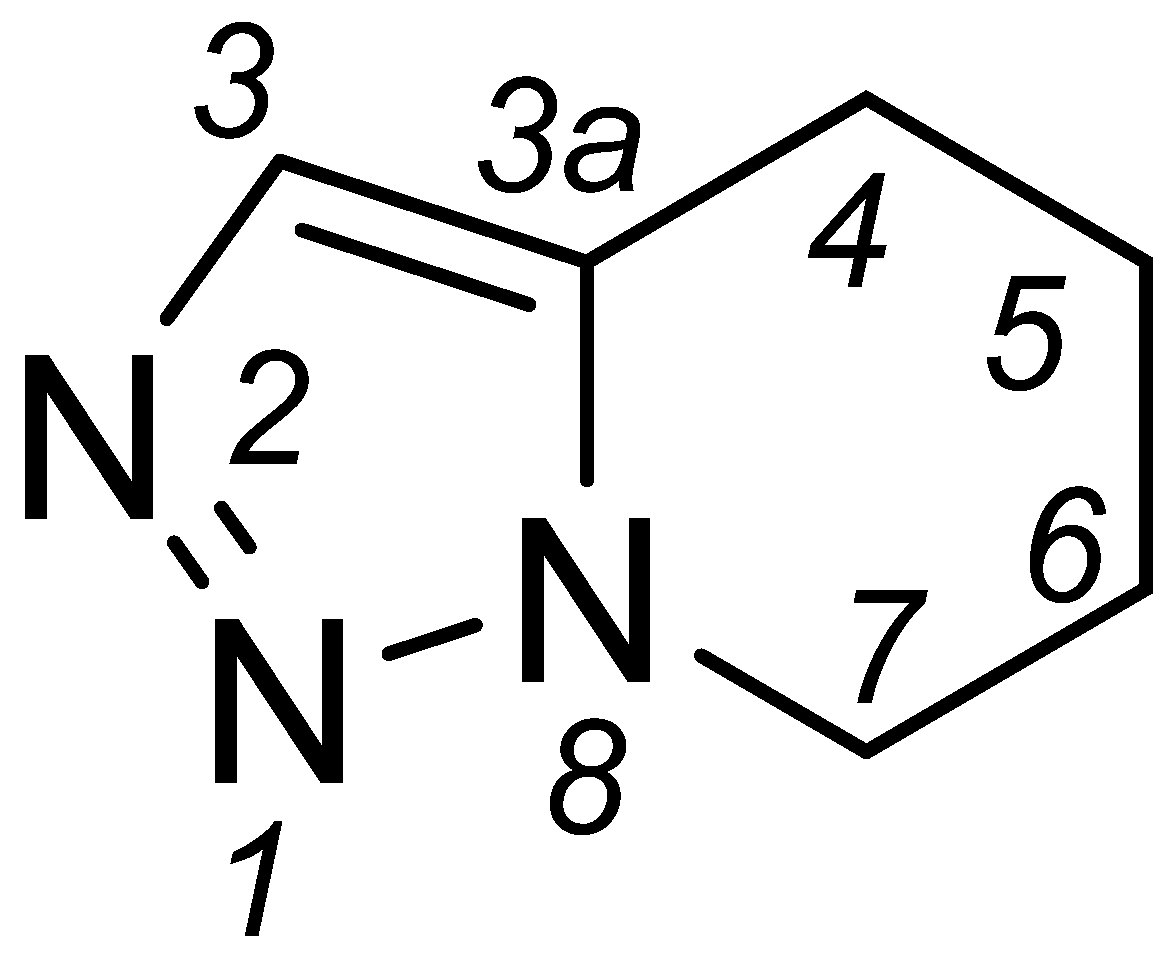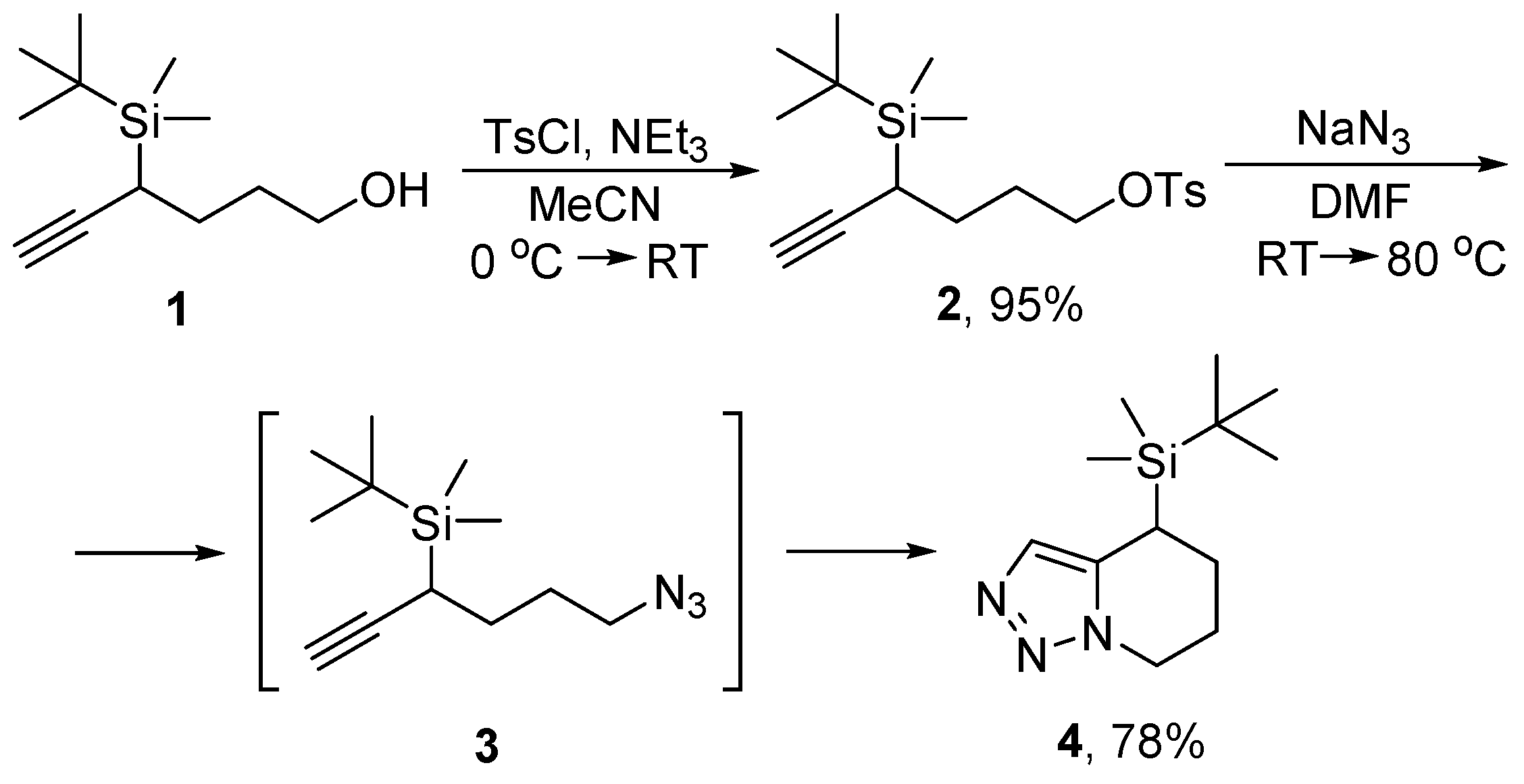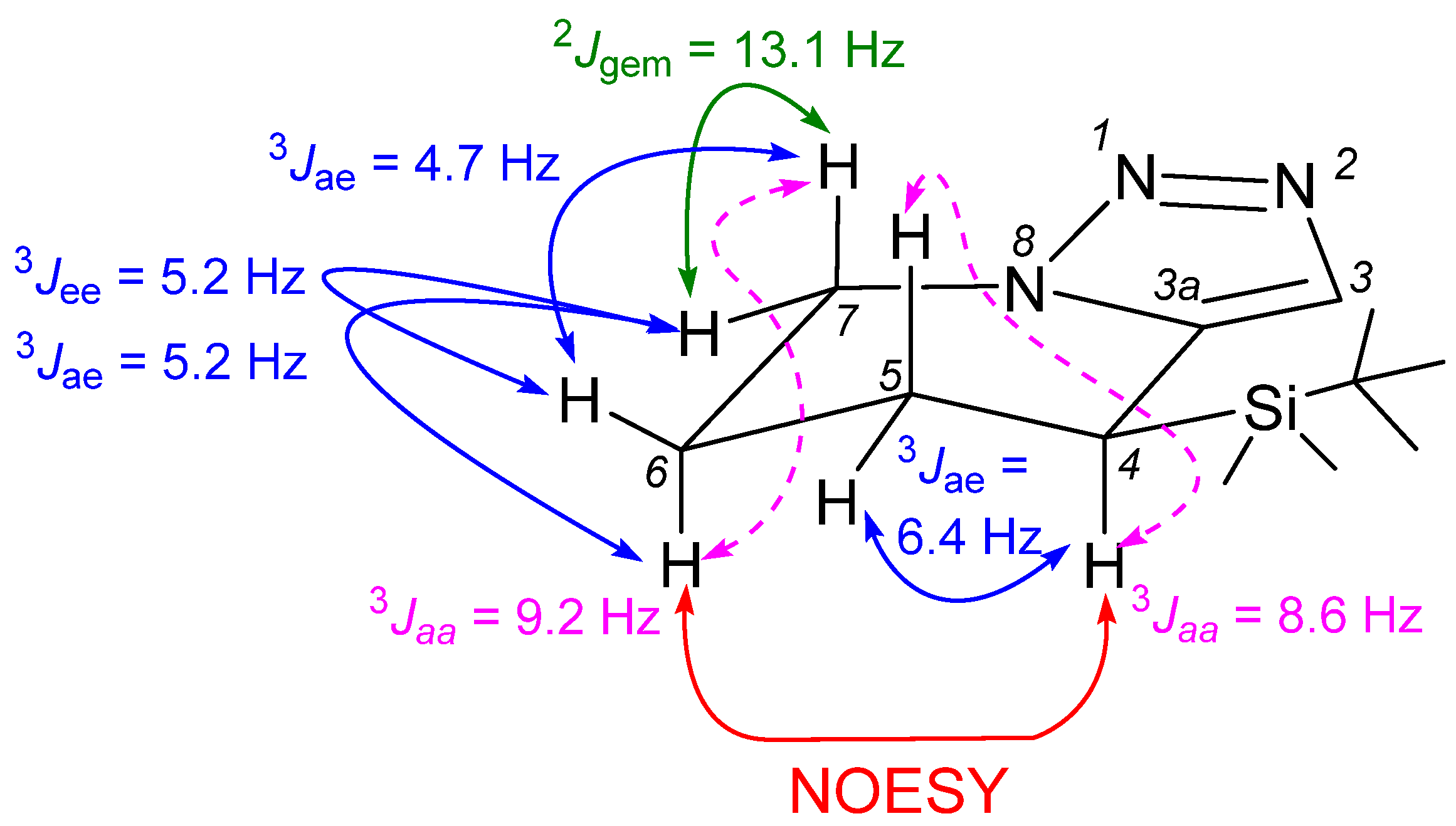Synthesis of 4-(tert-Butyldimethylsilyl)-4,5,6,7-tetrahydro-[1,2,3]triazolo[1,5-a]pyridine
Abstract
:1. Introduction
2. Results and Discussion
3. Materials and Methods
4. Conclusions
Supplementary Materials
Author Contributions
Funding
Institutional Review Board Statement
Informed Consent Statement
Data Availability Statement
Conflicts of Interest
Sample Availability
References
- Jonesa, G.; Abarca, B. The Chemistry of the [1,2,3]Triazolo[1,5-a]pyridines: An Update. Adv. Heterocycl. Chem. 2010, 100, 195–252. [Google Scholar] [CrossRef]
- Abarca-González, B. The Chemistry of [1,2,3]Triazolo[1,5-a]pyridines. J. Enz. Inhib. Med. Chem. 2002, 17, 359–367. [Google Scholar] [CrossRef] [PubMed]
- Eriksen, B.L.; Gustafsson, M.; Hougaard, C.; Jacobsen, T.A.; Jefson, M.R.; Klein, J.; Larsen, J.S.; Lowe, J.A., III; McCall, J.M.; Strooebaek, D.; et al. Preparation of Cycloalkylamino Nitrogen Heterocycles as Potassium Channel Modulators for the Treatment and Prevention of Disorders. U.S. Patent US10774064B2, 15 September 2020. [Google Scholar]
- Barlaam, B.; Casella, R.; Cidado, J.; Cook, C.; De Savi, C.; Dishington, A.; Donald, C.S.; Drew, L.; Ferguson, A.D.; Ferguson, D.; et al. Discovery of AZD4573, a Potent and Selective Inhibitor of CDK9 That Enables Short Duration of Target Engagement for the Treatment of Hematological Malignancies. J. Med. Chem. 2020, 63, 15564–15590. [Google Scholar] [CrossRef] [PubMed]
- Li, H.-Y.; Chen, C.-Y.; Cheng, H.-T.; Chu, Y.-H. Exploiting 1,2,3-Triazolium Ionic Liquids for Synthesis of Tryptanthrin and Chemoselective Extraction of Copper(II) Ions and Histidine-Containing Peptides. Molecules 2016, 21, 1355. [Google Scholar] [CrossRef] [PubMed]
- Lau, G.P.S.; Tsao, H.N.; Zakeeruddin, S.M.; Gratzel, M.; Dyson, P.J. Highly Stable Dye-Sensitized Solar Cells Based on Novel 1,2,3-Triazolium Ionic Liquids. ACS Appl. Mater. Interfaces 2014, 6, 13571–13577. [Google Scholar] [CrossRef] [PubMed]
- Yadagiri, D.; Rivas, M.; Gevorgyan, V. Denitrogenative Transformations of Pyridotriazoles and Related Compounds: Synthesis of N-Containing Heterocyclic Compounds and Beyond. J. Org. Chem. 2020, 85, 11030–11046. [Google Scholar] [CrossRef] [PubMed]
- Abarca, B.; Ballesteros, R.; Elmasnouy, M. Triazolopyridines 20. Hydrogenation reactions. Tetrahedron 1999, 55, 12881–12884. [Google Scholar] [CrossRef]
- Abarca, B.; Adam, R.; Alom, S.; Ballesteros, R.; Lopez-Molina, S. Triazolopyridines. Part 30. Hydrogen transfer reactions; pyridylcarbene formation. ARKIVOC Arch. Org. Chem. 2013, 2014, 175–186. [Google Scholar] [CrossRef]
- Alonso, F.; Moglie, Y.; Radivoy, G.; Yus, M. Click chemistry from organic halides, diazonium salts and anilines in water catalysed by copper nanoparticles on activated carbon. Org. Biomol. Chem. 2011, 9, 6385–6395. [Google Scholar] [CrossRef]
- Alonso, F.; Moglie, Y.; Radivoy, G.; Yus, M. Multicomponent Synthesis of 1,2,3-Triazoles in Water Catalyzed by Copper Nanoparticles on Activated Carbon. Adv. Synth. Catal. 2010, 352, 3208–3214. [Google Scholar] [CrossRef]
- Montevecchi, P.C.; Navacchia, M.L.; Spagnolo, P. A study of vinyl radical cyclization onto the azido group by addition of sulfanyl, stannyl, and silyl radicals to alkynyl azides. Eur. J. Org. Chem. 1998, 1998, 1219–1226. [Google Scholar] [CrossRef]
- Clark, J.S.; Hodgson, P.B.; Goldsmith, M.D.; Street, L.J. Rearrangement of ammonium ylides produced by intramolecular reaction of catalytically generated metal carbenoids. Part 1. Synthesis of cyclic amines. J. Chem. Soc. Perkin Trans. 1 2001, 24, 3312–3324. [Google Scholar] [CrossRef]
- Puriņš, M.; Mishnev, A.; Turks, M. Brønsted Acid Catalyzed 1,2-Silyl Shift in Propargyl Silanes: Synthesis of Silyl Dienes and Silyl Indenes. J. Org. Chem. 2019, 84, 3595–3611. [Google Scholar] [CrossRef] [PubMed]
- Beļaunieks, R.; Puriņš, M.; Kumpiņš, V.; Turks, M. Synthesis of 3-Silylated 3-Sulfolenes from Propargylsilanes and their Reductive Desulfitation. Chem. Heterocycl. Comp. 2021, 57, 20–25. [Google Scholar] [CrossRef]
- Beļaunieks, R.; Puriņš, M.; Turks, M. Manifestation of the β-Silicon Effect in the Reactions of Unsaturated Systems Involving a 1,2-Silyl Shift. Synthesis 2020, 52, 2147–2161. [Google Scholar] [CrossRef]
- Wang, X.; Gao, Q.; Buevich, A.V.; Yasuda, N.; Zhang, Y.; Yang, R.; Zhang, L.K.; Martin, G.E.; Williamson, R.T. Unexpected Propargylic Retro-Brook Rearrangements in Alkynes. J. Org. Chem. 2019, 84, 10024–10031. [Google Scholar] [CrossRef] [PubMed]
- Sore, H.F.; Galloway, W.R.J.D.; Spring, D.R. Palladium-catalysed cross-coupling of organosilicon reagents. Chem. Soc. Rev. 2012, 41, 1845–1866. [Google Scholar] [CrossRef] [PubMed]
- Tamao, K. Discovery and synthetic applications of novel silicon-carbon bond cleavage reactions based on the coordination number change of organosilicon compounds. Proc. Jpn. Acad. Ser. B Phys. Biol. Sci. 2008, 84, 123–133. [Google Scholar] [CrossRef] [PubMed]
- Jones, G.R.; Landais, Y. The Oxidation of the Carbon-Silicon Bond. Tetrahedron 1996, 52, 7599–7662. [Google Scholar] [CrossRef]
- Tanaka, S.; Velen, S.R.; Miller, S.I. Syntheses and properties of H-1,2,3-triazoles. Tetrahedron 1973, 29, 3271–3283. [Google Scholar] [CrossRef]



| Compound |  This work: ppm, 1H and 13C-NMR (CDCl3) |  | ||
|---|---|---|---|---|
| Atoms | ppm, [5] 1H-NMR (CDCl3), 13C-NMR (DMSO-d6) | ppm, [13] 1H and 13C-NMR (CDCl3) | ||
| H-C(3) | 7.37 | 7.44 | 7.43 | |
| H-C(4) | 2.46 | 2.84 | 2.84 | |
| H-C(7) | 4.52–4.44 4.28–4.19 | 4.37 | 4.36 | |
| H-C(5) | 2.15–2.06 | 2.02–2.14 | 2.13–2.00 | |
| and H-C(6) | 1.95–1.82 | 1.86–1.97 | 1.99–1.86 | |
| C(4) | 23.1 | 22.4 | 22.6 | |
| C(5) and C(6) | 23.4, 19.3 | 19.80, 19.82 | both at 19.9 | |
| C(7) | 46.2 | 45.7 | 45.8 | |
| C(3) and C(3a) | 135.8, 130.5 | 133.0, 130.3 | 133.1, 130.4 | |
Publisher’s Note: MDPI stays neutral with regard to jurisdictional claims in published maps and institutional affiliations. |
© 2022 by the authors. Licensee MDPI, Basel, Switzerland. This article is an open access article distributed under the terms and conditions of the Creative Commons Attribution (CC BY) license (https://creativecommons.org/licenses/by/4.0/).
Share and Cite
Kroņkalne, R.; Beļaunieks, R.; Turks, M. Synthesis of 4-(tert-Butyldimethylsilyl)-4,5,6,7-tetrahydro-[1,2,3]triazolo[1,5-a]pyridine. Molbank 2022, 2022, M1427. https://doi.org/10.3390/M1427
Kroņkalne R, Beļaunieks R, Turks M. Synthesis of 4-(tert-Butyldimethylsilyl)-4,5,6,7-tetrahydro-[1,2,3]triazolo[1,5-a]pyridine. Molbank. 2022; 2022(3):M1427. https://doi.org/10.3390/M1427
Chicago/Turabian StyleKroņkalne, Rasma, Rūdolfs Beļaunieks, and Māris Turks. 2022. "Synthesis of 4-(tert-Butyldimethylsilyl)-4,5,6,7-tetrahydro-[1,2,3]triazolo[1,5-a]pyridine" Molbank 2022, no. 3: M1427. https://doi.org/10.3390/M1427
APA StyleKroņkalne, R., Beļaunieks, R., & Turks, M. (2022). Synthesis of 4-(tert-Butyldimethylsilyl)-4,5,6,7-tetrahydro-[1,2,3]triazolo[1,5-a]pyridine. Molbank, 2022(3), M1427. https://doi.org/10.3390/M1427




